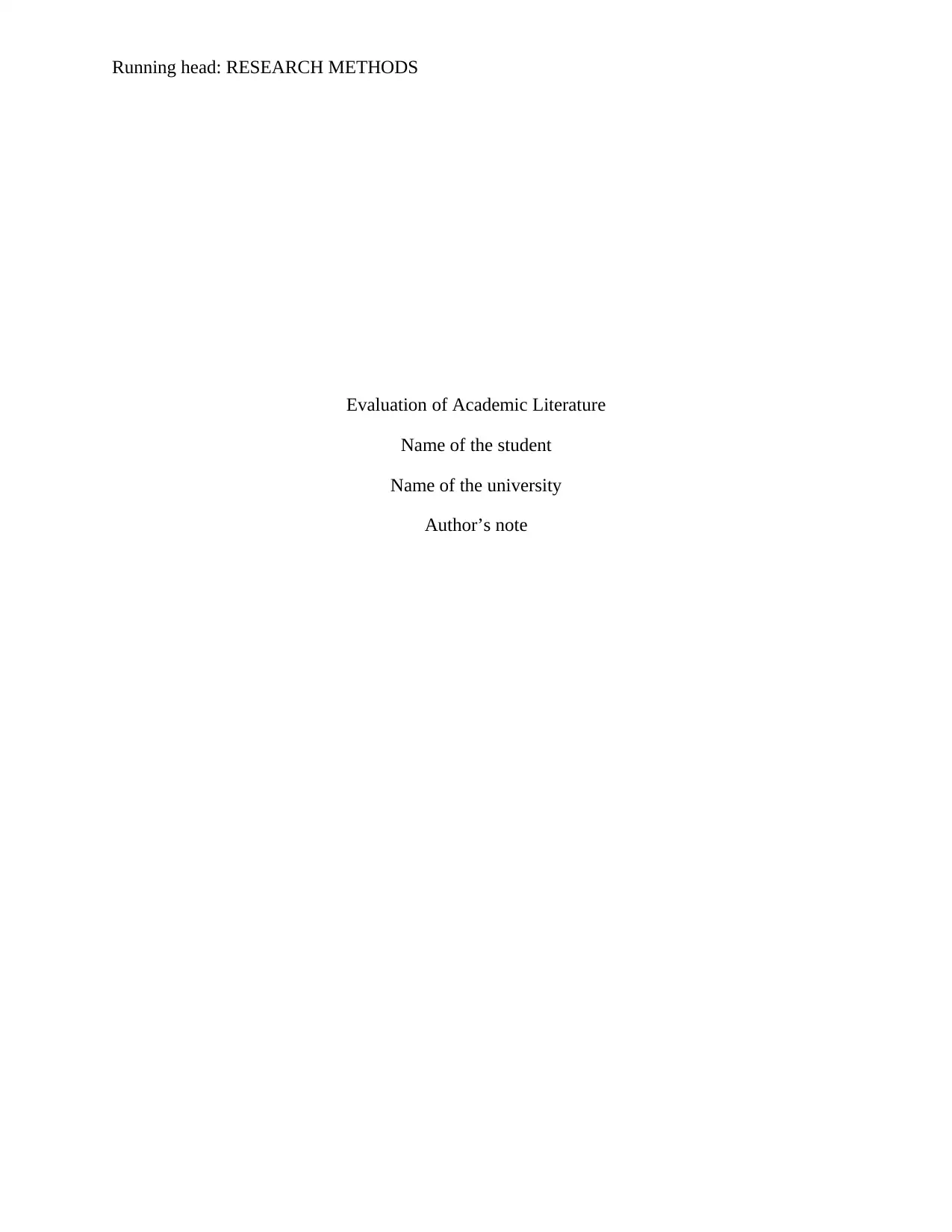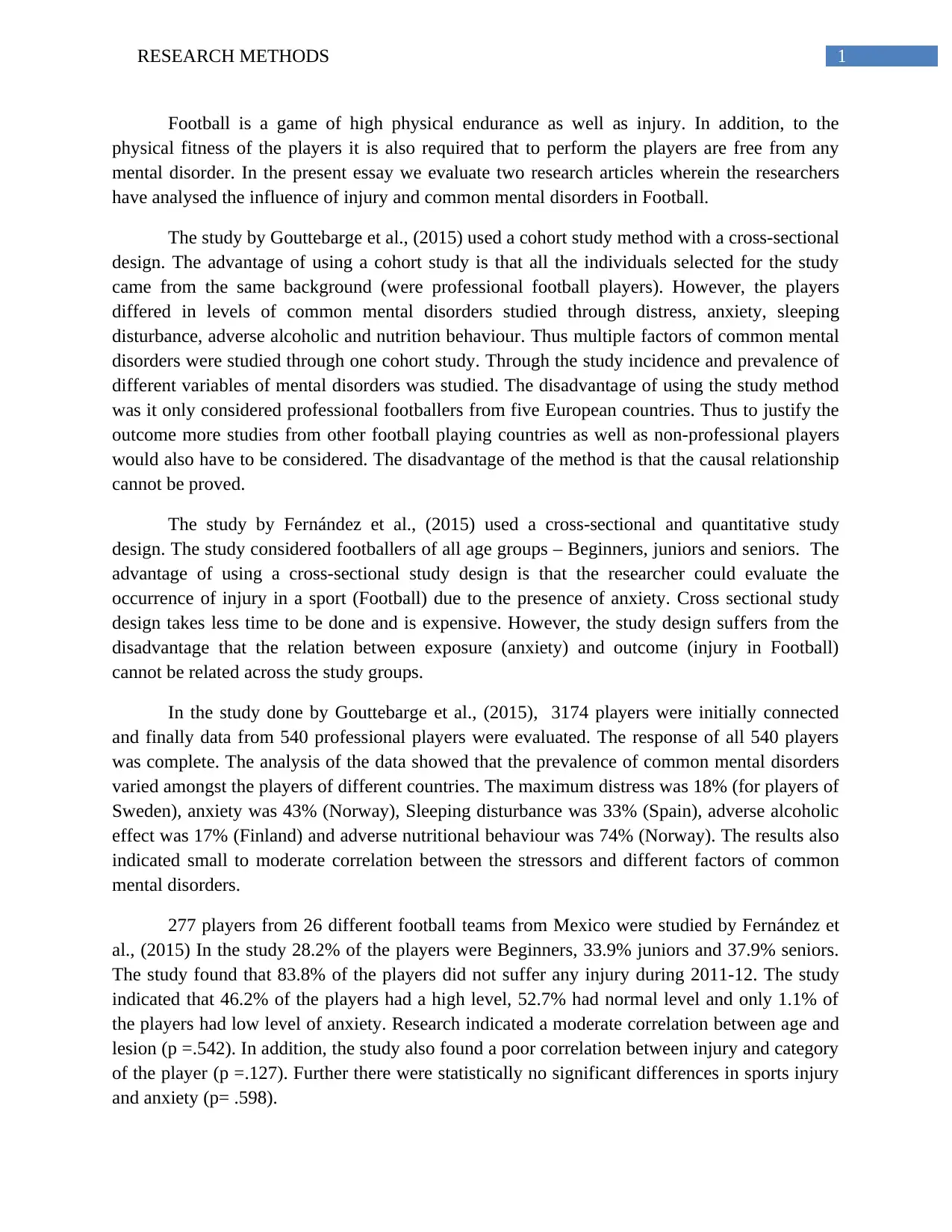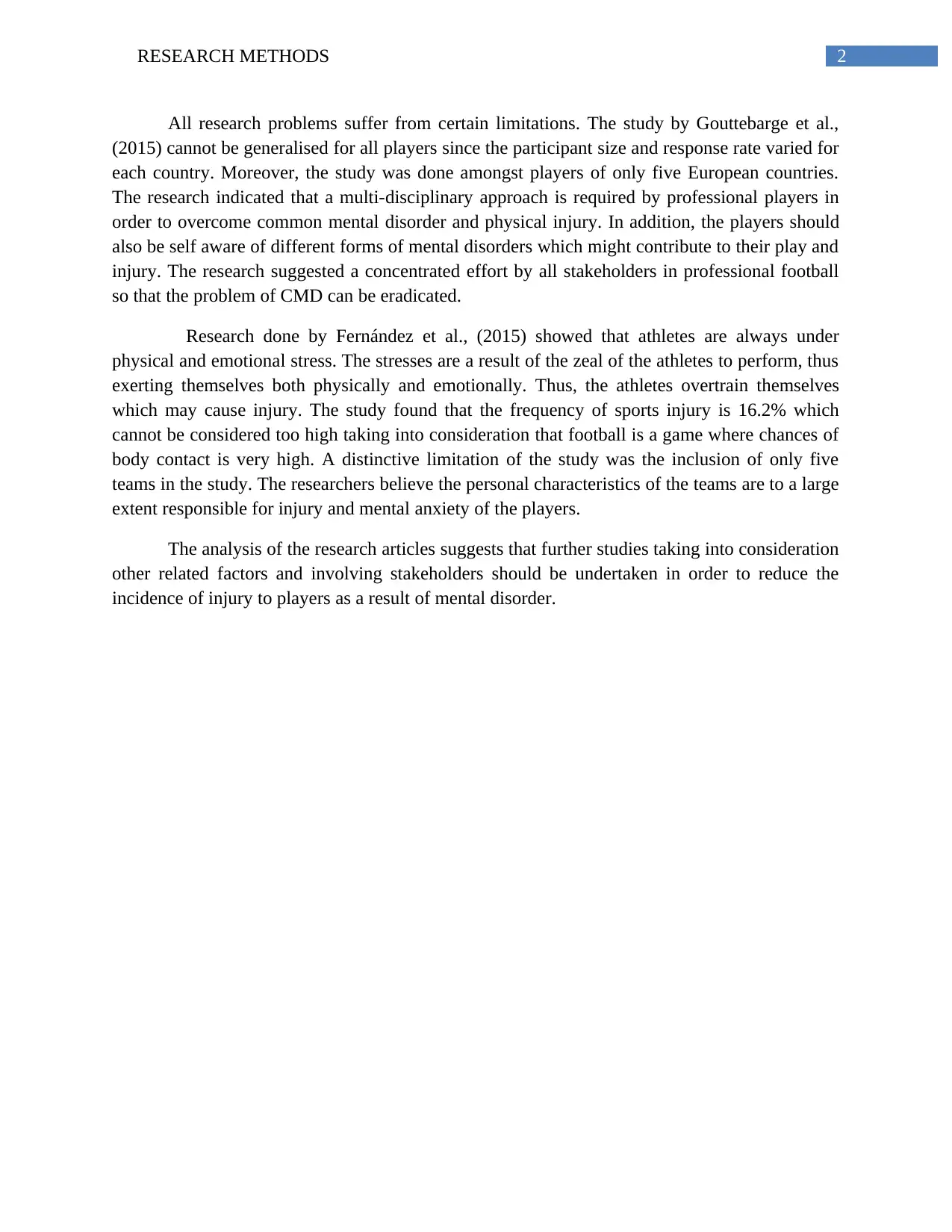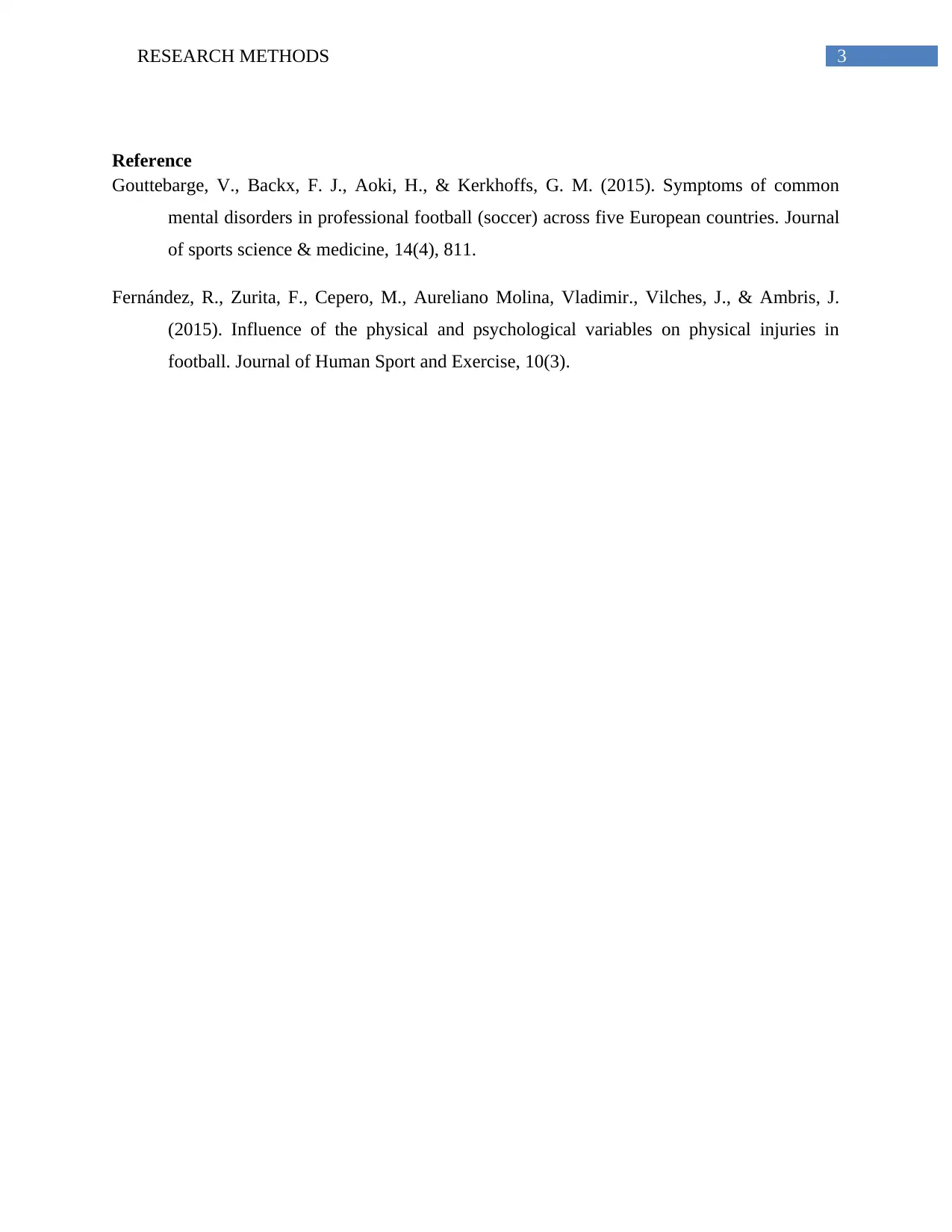Research Methods: Evaluation of Football Injury and Mental Health
VerifiedAdded on 2020/04/21
|4
|1025
|237
Report
AI Summary
This report analyzes two research articles examining the influence of injury and mental health on football players. The first study, by Gouttebarge et al. (2015), utilized a cohort study with a cross-sectional design, investigating the prevalence of common mental disorders across five European countries. The second study, by Fernández et al. (2015), employed a cross-sectional and quantitative design, focusing on the relationship between anxiety and injury in footballers of all age groups in Mexico. The report evaluates the methodologies, findings, limitations, and correlations between stressors, mental disorders, and physical injuries. The analysis highlights the need for a multidisciplinary approach and further research involving stakeholders to reduce the incidence of injury and mental health issues among football players, emphasizing the importance of self-awareness and concentrated efforts by all stakeholders in professional football.

Running head: RESEARCH METHODS
Evaluation of Academic Literature
Name of the student
Name of the university
Author’s note
Evaluation of Academic Literature
Name of the student
Name of the university
Author’s note
Paraphrase This Document
Need a fresh take? Get an instant paraphrase of this document with our AI Paraphraser

1RESEARCH METHODS
Football is a game of high physical endurance as well as injury. In addition, to the
physical fitness of the players it is also required that to perform the players are free from any
mental disorder. In the present essay we evaluate two research articles wherein the researchers
have analysed the influence of injury and common mental disorders in Football.
The study by Gouttebarge et al., (2015) used a cohort study method with a cross-sectional
design. The advantage of using a cohort study is that all the individuals selected for the study
came from the same background (were professional football players). However, the players
differed in levels of common mental disorders studied through distress, anxiety, sleeping
disturbance, adverse alcoholic and nutrition behaviour. Thus multiple factors of common mental
disorders were studied through one cohort study. Through the study incidence and prevalence of
different variables of mental disorders was studied. The disadvantage of using the study method
was it only considered professional footballers from five European countries. Thus to justify the
outcome more studies from other football playing countries as well as non-professional players
would also have to be considered. The disadvantage of the method is that the causal relationship
cannot be proved.
The study by Fernández et al., (2015) used a cross-sectional and quantitative study
design. The study considered footballers of all age groups – Beginners, juniors and seniors. The
advantage of using a cross-sectional study design is that the researcher could evaluate the
occurrence of injury in a sport (Football) due to the presence of anxiety. Cross sectional study
design takes less time to be done and is expensive. However, the study design suffers from the
disadvantage that the relation between exposure (anxiety) and outcome (injury in Football)
cannot be related across the study groups.
In the study done by Gouttebarge et al., (2015), 3174 players were initially connected
and finally data from 540 professional players were evaluated. The response of all 540 players
was complete. The analysis of the data showed that the prevalence of common mental disorders
varied amongst the players of different countries. The maximum distress was 18% (for players of
Sweden), anxiety was 43% (Norway), Sleeping disturbance was 33% (Spain), adverse alcoholic
effect was 17% (Finland) and adverse nutritional behaviour was 74% (Norway). The results also
indicated small to moderate correlation between the stressors and different factors of common
mental disorders.
277 players from 26 different football teams from Mexico were studied by Fernández et
al., (2015) In the study 28.2% of the players were Beginners, 33.9% juniors and 37.9% seniors.
The study found that 83.8% of the players did not suffer any injury during 2011-12. The study
indicated that 46.2% of the players had a high level, 52.7% had normal level and only 1.1% of
the players had low level of anxiety. Research indicated a moderate correlation between age and
lesion (p =.542). In addition, the study also found a poor correlation between injury and category
of the player (p =.127). Further there were statistically no significant differences in sports injury
and anxiety (p= .598).
Football is a game of high physical endurance as well as injury. In addition, to the
physical fitness of the players it is also required that to perform the players are free from any
mental disorder. In the present essay we evaluate two research articles wherein the researchers
have analysed the influence of injury and common mental disorders in Football.
The study by Gouttebarge et al., (2015) used a cohort study method with a cross-sectional
design. The advantage of using a cohort study is that all the individuals selected for the study
came from the same background (were professional football players). However, the players
differed in levels of common mental disorders studied through distress, anxiety, sleeping
disturbance, adverse alcoholic and nutrition behaviour. Thus multiple factors of common mental
disorders were studied through one cohort study. Through the study incidence and prevalence of
different variables of mental disorders was studied. The disadvantage of using the study method
was it only considered professional footballers from five European countries. Thus to justify the
outcome more studies from other football playing countries as well as non-professional players
would also have to be considered. The disadvantage of the method is that the causal relationship
cannot be proved.
The study by Fernández et al., (2015) used a cross-sectional and quantitative study
design. The study considered footballers of all age groups – Beginners, juniors and seniors. The
advantage of using a cross-sectional study design is that the researcher could evaluate the
occurrence of injury in a sport (Football) due to the presence of anxiety. Cross sectional study
design takes less time to be done and is expensive. However, the study design suffers from the
disadvantage that the relation between exposure (anxiety) and outcome (injury in Football)
cannot be related across the study groups.
In the study done by Gouttebarge et al., (2015), 3174 players were initially connected
and finally data from 540 professional players were evaluated. The response of all 540 players
was complete. The analysis of the data showed that the prevalence of common mental disorders
varied amongst the players of different countries. The maximum distress was 18% (for players of
Sweden), anxiety was 43% (Norway), Sleeping disturbance was 33% (Spain), adverse alcoholic
effect was 17% (Finland) and adverse nutritional behaviour was 74% (Norway). The results also
indicated small to moderate correlation between the stressors and different factors of common
mental disorders.
277 players from 26 different football teams from Mexico were studied by Fernández et
al., (2015) In the study 28.2% of the players were Beginners, 33.9% juniors and 37.9% seniors.
The study found that 83.8% of the players did not suffer any injury during 2011-12. The study
indicated that 46.2% of the players had a high level, 52.7% had normal level and only 1.1% of
the players had low level of anxiety. Research indicated a moderate correlation between age and
lesion (p =.542). In addition, the study also found a poor correlation between injury and category
of the player (p =.127). Further there were statistically no significant differences in sports injury
and anxiety (p= .598).

2RESEARCH METHODS
All research problems suffer from certain limitations. The study by Gouttebarge et al.,
(2015) cannot be generalised for all players since the participant size and response rate varied for
each country. Moreover, the study was done amongst players of only five European countries.
The research indicated that a multi-disciplinary approach is required by professional players in
order to overcome common mental disorder and physical injury. In addition, the players should
also be self aware of different forms of mental disorders which might contribute to their play and
injury. The research suggested a concentrated effort by all stakeholders in professional football
so that the problem of CMD can be eradicated.
Research done by Fernández et al., (2015) showed that athletes are always under
physical and emotional stress. The stresses are a result of the zeal of the athletes to perform, thus
exerting themselves both physically and emotionally. Thus, the athletes overtrain themselves
which may cause injury. The study found that the frequency of sports injury is 16.2% which
cannot be considered too high taking into consideration that football is a game where chances of
body contact is very high. A distinctive limitation of the study was the inclusion of only five
teams in the study. The researchers believe the personal characteristics of the teams are to a large
extent responsible for injury and mental anxiety of the players.
The analysis of the research articles suggests that further studies taking into consideration
other related factors and involving stakeholders should be undertaken in order to reduce the
incidence of injury to players as a result of mental disorder.
All research problems suffer from certain limitations. The study by Gouttebarge et al.,
(2015) cannot be generalised for all players since the participant size and response rate varied for
each country. Moreover, the study was done amongst players of only five European countries.
The research indicated that a multi-disciplinary approach is required by professional players in
order to overcome common mental disorder and physical injury. In addition, the players should
also be self aware of different forms of mental disorders which might contribute to their play and
injury. The research suggested a concentrated effort by all stakeholders in professional football
so that the problem of CMD can be eradicated.
Research done by Fernández et al., (2015) showed that athletes are always under
physical and emotional stress. The stresses are a result of the zeal of the athletes to perform, thus
exerting themselves both physically and emotionally. Thus, the athletes overtrain themselves
which may cause injury. The study found that the frequency of sports injury is 16.2% which
cannot be considered too high taking into consideration that football is a game where chances of
body contact is very high. A distinctive limitation of the study was the inclusion of only five
teams in the study. The researchers believe the personal characteristics of the teams are to a large
extent responsible for injury and mental anxiety of the players.
The analysis of the research articles suggests that further studies taking into consideration
other related factors and involving stakeholders should be undertaken in order to reduce the
incidence of injury to players as a result of mental disorder.
⊘ This is a preview!⊘
Do you want full access?
Subscribe today to unlock all pages.

Trusted by 1+ million students worldwide

3RESEARCH METHODS
Reference
Gouttebarge, V., Backx, F. J., Aoki, H., & Kerkhoffs, G. M. (2015). Symptoms of common
mental disorders in professional football (soccer) across five European countries. Journal
of sports science & medicine, 14(4), 811.
Fernández, R., Zurita, F., Cepero, M., Aureliano Molina, Vladimir., Vilches, J., & Ambris, J.
(2015). Influence of the physical and psychological variables on physical injuries in
football. Journal of Human Sport and Exercise, 10(3).
Reference
Gouttebarge, V., Backx, F. J., Aoki, H., & Kerkhoffs, G. M. (2015). Symptoms of common
mental disorders in professional football (soccer) across five European countries. Journal
of sports science & medicine, 14(4), 811.
Fernández, R., Zurita, F., Cepero, M., Aureliano Molina, Vladimir., Vilches, J., & Ambris, J.
(2015). Influence of the physical and psychological variables on physical injuries in
football. Journal of Human Sport and Exercise, 10(3).
1 out of 4
Related Documents
Your All-in-One AI-Powered Toolkit for Academic Success.
+13062052269
info@desklib.com
Available 24*7 on WhatsApp / Email
![[object Object]](/_next/static/media/star-bottom.7253800d.svg)
Unlock your academic potential
Copyright © 2020–2025 A2Z Services. All Rights Reserved. Developed and managed by ZUCOL.



